
Berberis aquifolium, the Oregon grape or holly-leaved barberry, is a species of flowering plant in the family Berberidaceae, native to western North America. It is an evergreen shrub growing 1–3 meters tall and 1.5 m (5 ft) wide, with pinnate leaves consisting of spiny leaflets, and dense clusters of yellow flowers in early spring, followed by dark bluish-black berries.

Mahonia is a formerly accepted genus of approximately 70 species of shrubs or, rarely, small trees with evergreen leaves in the family Berberidaceae, native to eastern Asia, the Himalaya, North America, and Central America. They are closely related to the genus Berberis and as of 2023 the majority of botanical sources list it as a synonym for Berberis.
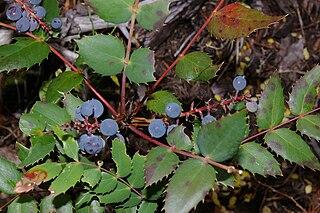
Mahonia nervosa, commonly known as dwarf Oregon-grape, Cascade barberry, Cascade Oregon-grape, or dull Oregon-grape, is a flowering plant native to the northwest coast of North America from southern British Columbia south to central California, with an isolated population inland in northern Idaho. It is especially common in second growth, Douglas-fir or western redcedar forests, making use of those pools of sunlight that intermittently reach the ground.

Berberis repens commonly known as creeping mahonia, creeping Oregon grape, or creeping barberry, is a species of Berberis native to most of the western United States and two western provinces of Canada. It has found use as a xeric ornamental plant and has escaped from cultivation in areas beyond its native range.
Berberis decipiens is a species of shrub in the Berberidaceae described as a species in 1913. It is endemic to Hubei Province in China. The species is listed as vulnerable by the IUCN.
Berberis piperiana is a shrub native to the mountains of northern California and southwestern Oregon. It is found in open and wooded slopes at elevations of 900–1,700 m (3,000–5,600 ft).
Berberis pimana is a species of the genus Berberis in the family Berberidaceae. It is native to a mountainous region of the Sierra Madre Occidental in the Mexican states of Chihuahua and Sonora.
Berberis chochoco is an evergreen shrub or small tree up to 9 m (30 ft) tall, in the genus Berberis, family Berberidaceae. It is native to mountainous regions of northeastern Mexico, in the states of Nuevo León, Veracruz, and San Luis Potosí.
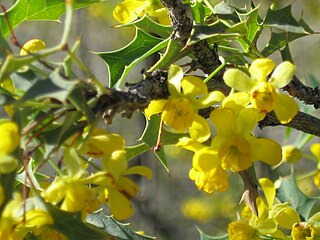
Berberis harrisoniana is a rare species of flowering plant in the barberry family, Berberidaceae. It is known by the common names Kofa barberry, Kofa Mountain barberry, Harrison's barberry, and red barberry.
Berberis swaseyi is a rare species of barberry endemic to the Edwards Plateau region of Texas. It grows in limestone ridges and canyons. The species is evergreen, with thick, rigid, 5-9-foliolate leaves. Berries are dry or juicy, white to red, about 9–16 mm in diam.

Berberis haematocarpa, Woot. with the common names red barberry, red Mexican barbery, Colorado barberry and Mexican barberry, is a species in the Barberry family in southwestern North America. It is also sometimes called algerita, but that name is more often applied to its relative, Mahonia trifoliolata.
Berberis wilcoxii is a shrub native to Arizona, New Mexico and Sonora. It is up to 2 m tall, with pinnately compound leaves of 5-7 leaflets, densely clustered racemes and ovoid berries up to 10 mm long. It is generally found in rocky canyons in mountainous areas at an elevation of 1700–2500 m.
Berberis muelleri is a shrub with compound leaves, native to the Mexican State of Nuevo León.
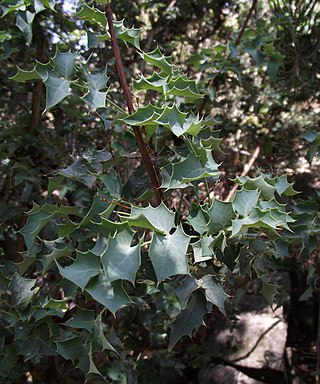
Berberis higginsiae is a shrub found only in a small region south and east of San Diego in southern California and northern Baja California. It grows in chaparral and woodland areas at elevations of 800–1,200 m (2,600–3,900 ft).
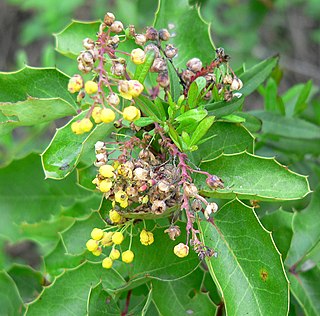
Berberis amplectens is a rare species of shrubs endemic to the Peninsular Ranges of southern California, east of San Diego.
Berberis pumila is a species of shrub native to Oregon and northern California. It is found in open woods and rocky areas at an altitude of 300–1,200 m (980–3,940 ft) in the Coast Ranges, the northern Sierra Nevada and the southern Cascades, often on serpentine soils.
Berberis bracteolata is a shrub in the Berberidaceae described as a species in 1917. It is endemic to China, known from Sichuan and Yunnan Provinces.
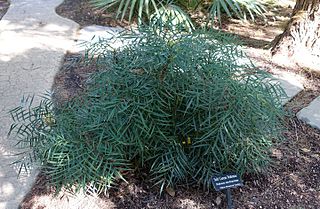
Berberis eurybracteata is a species of shrub in the Berberidaceae described as a species in 1901. It is endemic to China.
Mahonia retinervis is a shrub in the family Berberidaceae described as a species in 1985. It is endemic to China in the Guangxi and Yunnan Provinces.
Berberis standleyi is a shrub in the Berberidaceae described as a species in 1952. It was published with the name Mahonia glauca, a very different plant from Berberis glauca. Thus if one desires to consider Berberis and Mahonia as one genus instead of two, it is necessary to use a different name, i.e. Berberis standleyi.








